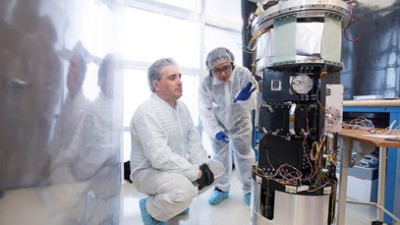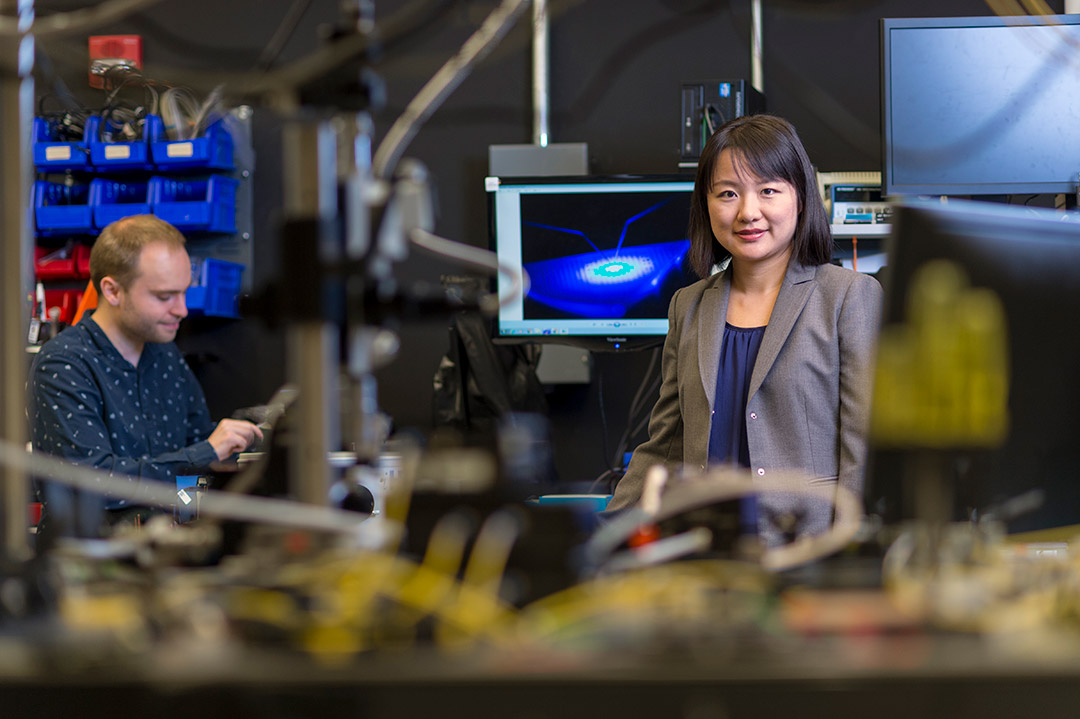NSF awards RIT nearly $3 million to advance semiconductor technologies
RIT will train graduate students for interdisciplinary research in essential semiconductor technologies
Jing Zhang, associate professor in RIT’s Kate Gleason College of Engineering, will be among the faculty-researchers mentoring master’s and doctoral students in semiconductor technologies through a new NSF grant.
Rochester Institute of Technology will provide 20 doctoral student fellowships to advance research in the much-needed field of semiconductor technologies.
The National Science Foundation awarded RIT nearly $3 million in funding for “Convergent Graduate Research Training in CMOS + X Semiconductor Technologies.” The award is part of the NSF’s Research Traineeship Program (NRT), a national initiative to better prepare master’s and doctoral students for the interdisciplinary talents required in semiconductor chip development. It also is a means to align training with evolving workforce demands and address a domestic semiconductor talent shortage.
RIT has significant expertise in microelectronic engineering and CMOS, or complementary metal-oxide-semiconductor technologies, one of the key development technologies to build and manufacture semiconductor chips.
Training opportunities will focus on next-generation CMOS+X (X = AI, biomedical, chemical, optoelectronic, photonic, nanoelectronic, quantum, and packaging) technologies—to address skill gaps in advanced materials and devices, characterizations, packaging, modeling and simulation, and semiconductor manufacturing processes and fabrications, said Jing Zhang, the principal investigator and project lead.
Seth Hubbard
Provided
“Our program will be one of the first to offer a transformative and dedicated graduate education training model with strong technical, professional, and DEI—diversity, equity and inclusion—components. We expect to prepare more than 170 next-generation semiconductor engineers and scientists to help close the workforce gap and to strengthen the nation’s semiconductor technology leadership,” said Zhang, the Kate Gleason associate professor in the Department of Electrical and Microelectronic Engineering in RIT’s Kate Gleason College of Engineering. As an expert in optoelectronic and nanoelectronic devices, she has been a key researcher in advancing wide bandgap semiconductors for ultraviolet and visible LEDs, lasers and vertical transistors.
Over the five years of the project, program leaders will work with students to advance research in four tracks: material innovation, micro- and nanoelectronics, optoelectronics and photonics, and integrated circuits, systems, and packaging. These focus areas have extensive and wide-ranging applications of semiconductor CMOS+X technologies in artificial intelligence, vehicle electrification, and high-performance and quantum computing, for example.
“This is game changing for our Ph.D. programs that have research aspects in semiconductor technology, since it will allow us to recruit top-level graduate students by offering them these fellowship opportunities,” said Seth Hubbard, one of the program’s co-PI’s. He is director of the NanoPower Research Laboratories, teaches in the microsystems engineering doctoral program, and leads the new physics Ph.D. program, based in the College of Science. “I believe this will provide strong growth in our programs, both in terms of students but also faculty.”
The NRT program addresses workforce development, emphasizing broad participation, and institutional capacity-building needs in graduate education through strategic collaborations with the industry, non-governmental organizations, government agencies, national laboratories, and academia.
Zhang and Hubbard will be joined as project leaders by engineering and science faculty-researchers Stefan Preble, Karl Hirschman, Parsian Mohseni, Ke Xu, Santosh Kurinec, Ivan Puchades, and Tejasvi Das. They will mentor students from the university’s master’s and doctoral programs in RIT’s Kate Gleason College of Engineering, the College of Science, the Golisano Institute for Sustainability and the National Technical Institute for the Deaf.









